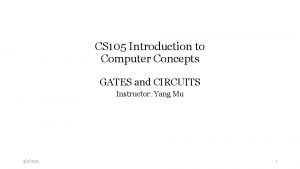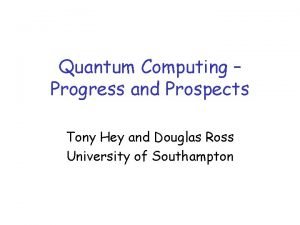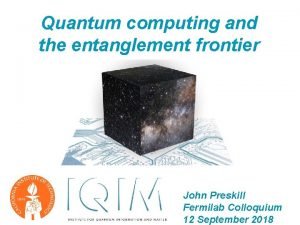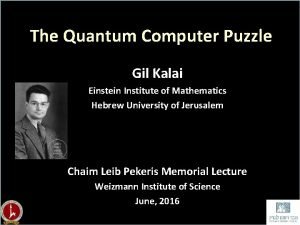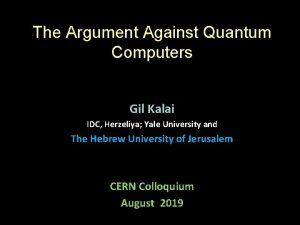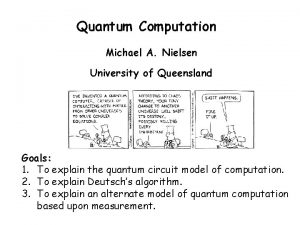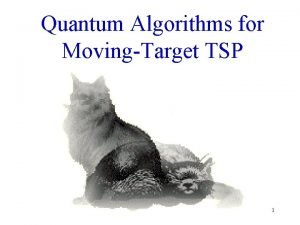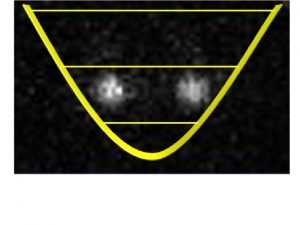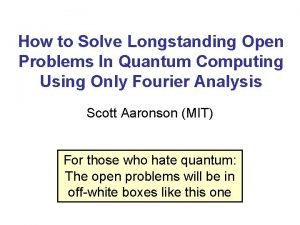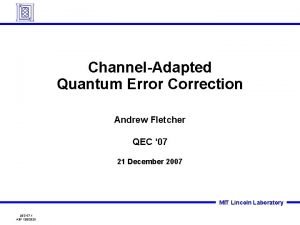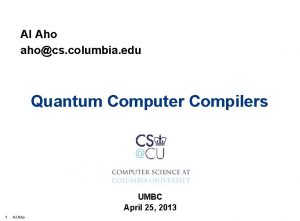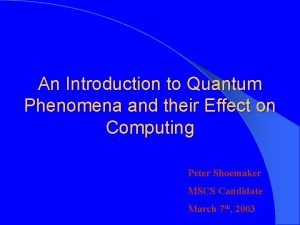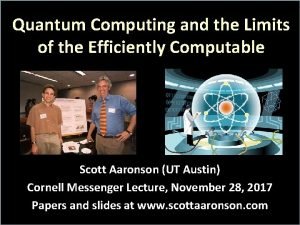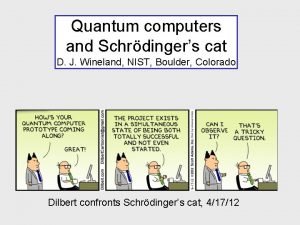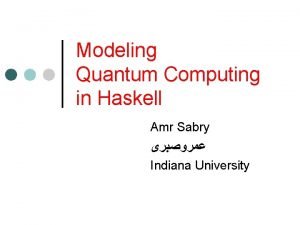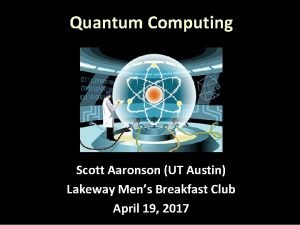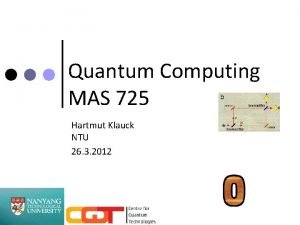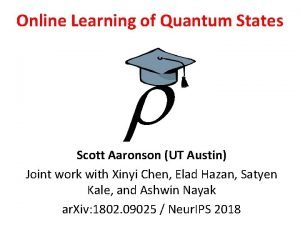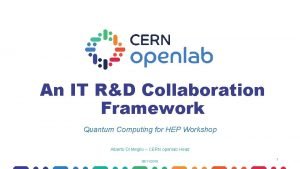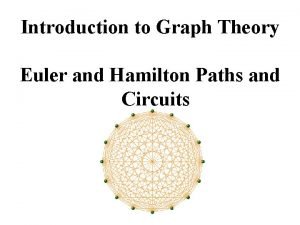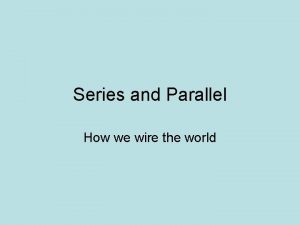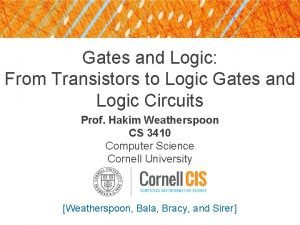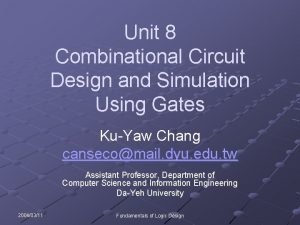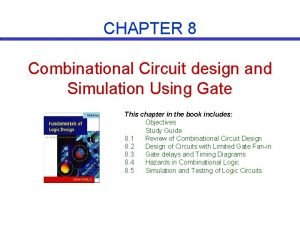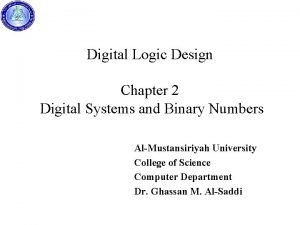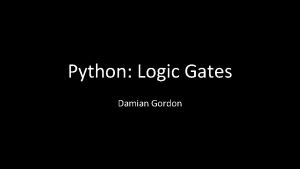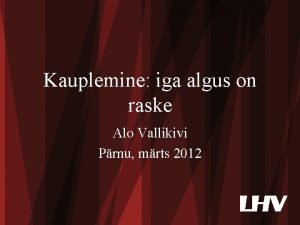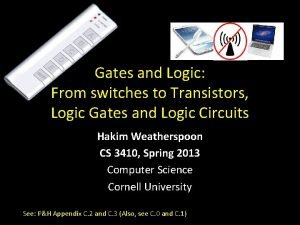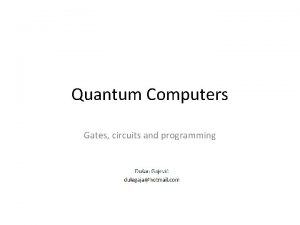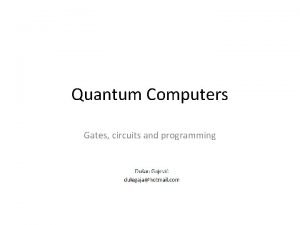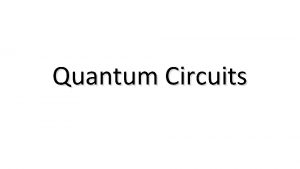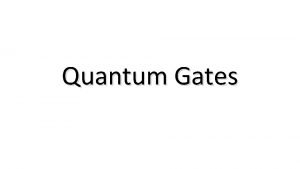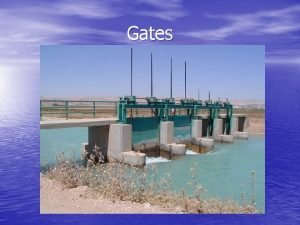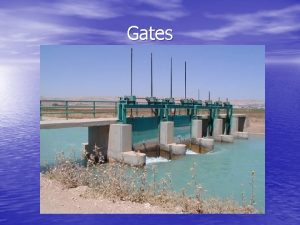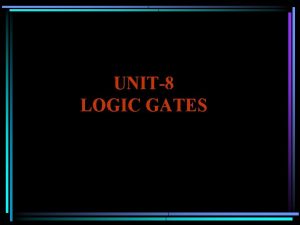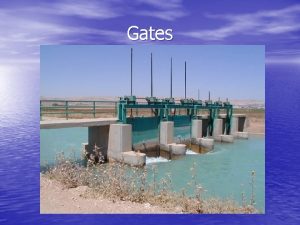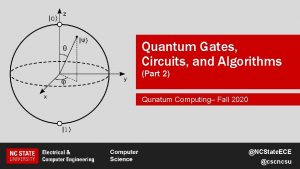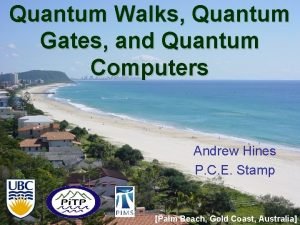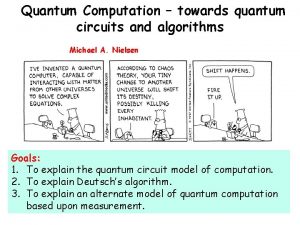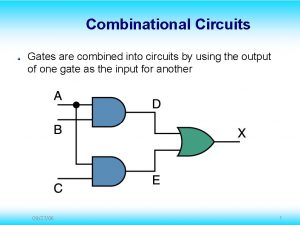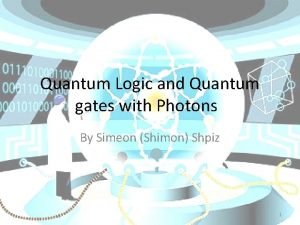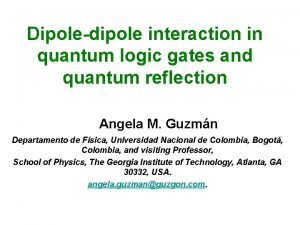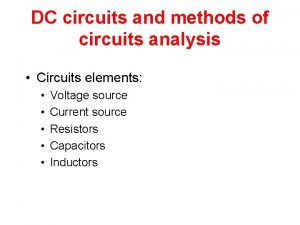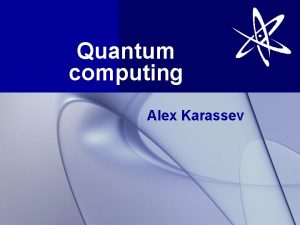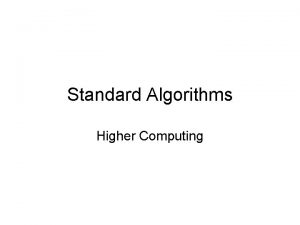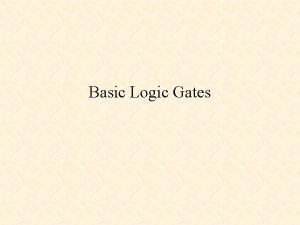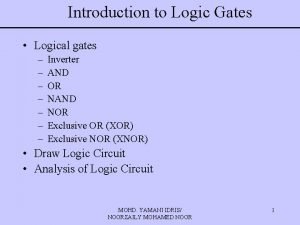Quantum Gates Circuits and Algorithms Quantum Computing Fall





































- Slides: 37

Quantum Gates, Circuits, and Algorithms Quantum Computing– Fall 2020 Compute r Science @NCState. ECE @cscncsu

Bloch Sphere Representation https: //en. wikipedia. org/wiki/Bloch_sphere

Quantum State (qubit) https: //en. wikipedia. org/wiki/Bloch_sphere

Quantum State (qubit) α β θ 1 0 0 0 1 state https: //en. wikipedia. org/wiki/Bloch_sphere

Quantum Gate Quantum gate is a transformation from one qubit state to another. Single-qubit gate = rotation around Bloch sphere. Reversible. Represented by a (unitary) matrix acting on the vector. https: //en. wikipedia. org/wiki/Bloch_sphere

Some Unitary Transformations Rotation around the Y axis. (Y = i. XZ) Pauli matrices

X Gate: NOT Start rotate by around the X axis Quirk demo: https: //algassert. com/quirk End

Hadamard (H) Gate: Superposition Star t Rotation around (X+Z)/ 2 -axis Also equivalent to 2 rotations: around Z-axis + /2 around Y-axis Or: /2 around X-axis + /2 around Z-axis End AKA

Phase: Z, S, T Rotations around the Z axis T = /4 S = /2 Z= Quirk demo: https: //algassert. com/quirk

Phase: Z, S, T

Y Gate Start rotate by around the Y axis End

Rotational Gates rotate by θ around the X axis rotate by θ around the Y axis rotate by θ around the Z axis

U Gates: u 1, u 2, u 3 The most general unitary gate IBM Gate Used to generate… T, T†, S, S†, Z H = u 2(0, )

Quantum Gates: Circuit

A word about implementation… Quotes from IBM Q material The qubit we use is a fixed-frequency superconducting transmon qubit. It is a Josephsonjunction-based qubit that is insensitive to charge noise. The devices are made on silicon wafers with superconducting metals such as niobium and aluminum. Koch, et al. Phys. Rev. A 76, 042319 –Oct 2007 Quantum gates are performed by sending electromagnetic impulses at microwave frequencies to the qubits through coaxial cables. These electromagnetic pulses have a particular duration, frequency, and phase that determine the angle of rotation of the qubit state around a particular axis of the Bloch sphere.

Multi-Qubit States

Multi-Qubit States

Two-qubit System Example

Entagled States i

Entagled States

Walsh-Hadamard Transform Used in the setup phase of algorithms, to create a superposition of all inputs. Transformations occur on all components of the superposition. This is the source of quantum parallelism. This is not an entangled state.

Two-qubit Gate: CNOT IBM notation: <q 1 q 0| CNOT = controlled-NOT = CX most textbooks: <q 0 q 1| Start End |01> |11> If q 0 = 1, flip q 1. Start End Be careful about notions of “control” and “target. ” More about this later… |10>

Two-qubit Gate: CNOT = controlled-NOT Start End Be careful about notions of “control” and “target. ” More about this later… Entanglement: Bell Pair

CNOT with Superposition Notice: IBM notation of |q 1 q 0> In general, CNOT is an entangling operation.

Generalized Control Gates CZ = controlled-Z CH = controlled-H CU = controlled-U U

Other Two-Bit Gates (IBM Qiskit) • controlled Pauli gates (X, Y, Z) – controlled X is CNOT • controlled Hadamard gate • controlled rotation gates (Rx, Ry, Rz) • controlled phase gate (u 1) • controlled u 3 gate • swap gate

A word about implementation… Quotes from IBM Q material Two-qubit gates typically require tuning to calibrate the interaction between the two qubits during the gate duration, and minimizing the interaction at any other time. Since our qubits of choice are fixed-frequency transmons, we cannot tune the interaction by bringing them closer in frequency during the two-qubit gate. Instead, we exploit the crossresonance effect, by driving one of the qubits (called control) with a microwave pulse tuned at the frequency of the second qubit (called target). By doing this, we can actively increase the strength of the coupling between them. The nature of the cross-resonance effect also allows us to perform rotations in the target qubit conditioned on the state of the control qubit, a key characteristic of the CNOT operation required for a universal quantum gate set. Hegade, et al. ar. Xiv: 1712. 07326 v 1, 9 Jul 2018.

No-Cloning Principle (revisited)

Three-qubit Gates Toffoli: controlled CNOT Fredkin: controlled swap These are not implemented directly on the IBM Q. They are built from 1 - and 2 -qubit gates.

Toffoli Gate

Toffoli: Reversible Classic Gates NOT AND NAND XOR

Quantum Circuit Measurement. Double line represents classical bit. Standard Circuit Model • CNOT plus all single-bit transformations • Measurement in the standard basis Time flows left to right. Quantum gates (operators) are applied sequentially to qubit states, with result shown on the right. Any quantum transformation can be realized in terms of the basic gates of the standard circuit model.

Example Circuit: Half Adder a b sum carry 0 0 0 1 1 0 1 0 1

What about superposition? NOT THIS Note: ignoring normalizing coefficients. entangled

Caution 1: Phases Quantum state transformations are specified in terms of actions in the vector space, not in terms of quantum state. (There’s a difference. ) Example – consider the controlled phase shift: Rieffel and Polak, 2014.

Caution 2: Notion of Control The notions of control and target bit is a carryover from the classical gate, and should not be taken too literally. Do not conclude that the control bit is never changed. Consider the CNOT gate operating in the Hadamard basis: Start End In this case, it’s the first qubit that changes.

Caution 3: Reading Circuit Diagram The graphical representation of a circuit can be misleading. Must “do the math” and figure out exactly what transformation is happening, even if all qubits are in the standard basis. What is the output of the following circuit?
 What is a parallel circuit in physics
What is a parallel circuit in physics Quantum gates
Quantum gates Computing 105m series gates 200m300mwiggersventurebeat
Computing 105m series gates 200m300mwiggersventurebeat Quantum computing progress and prospects
Quantum computing progress and prospects Quantum computing
Quantum computing Conventional computing and intelligent computing
Conventional computing and intelligent computing Quantum physics vs mechanics
Quantum physics vs mechanics Quantum physics vs mechanics
Quantum physics vs mechanics Gil kalai quantum computing
Gil kalai quantum computing Gil kalai quantum computing
Gil kalai quantum computing Nielsen quantum computing
Nielsen quantum computing Tsp
Tsp Quantum computing prerequisites
Quantum computing prerequisites Open problems in quantum computing
Open problems in quantum computing Mit quantum computing
Mit quantum computing Mit quantum computing
Mit quantum computing Quantum computing meaning
Quantum computing meaning Quantum computing
Quantum computing Dilbert quantum computing
Dilbert quantum computing Haskell quantum computing
Haskell quantum computing Scott aaronson ut austin
Scott aaronson ut austin Ntu quantum computing
Ntu quantum computing Ut austin quantum computing
Ut austin quantum computing Cern openlab quantum computing
Cern openlab quantum computing Euler circuit
Euler circuit Euler and hamilton paths and circuits
Euler and hamilton paths and circuits Pros and cons of series circuits
Pros and cons of series circuits Or gate timing diagram
Or gate timing diagram Logic gates with truth table
Logic gates with truth table Bill gates achievements and awards
Bill gates achievements and awards Combinational circuit design and simulation using gates
Combinational circuit design and simulation using gates Simulation and testing of logic circuits
Simulation and testing of logic circuits Binary code
Binary code Logic gates and
Logic gates and Alo vallikivi
Alo vallikivi Logic gates and
Logic gates and Computational thinking algorithms and programming
Computational thinking algorithms and programming Design and analysis of algorithms syllabus
Design and analysis of algorithms syllabus


